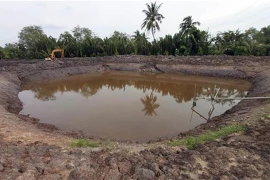 Farmers in Go Cong Tay district, Tien Giang province harvest their 2020-2021 winter-sprining crop. (Photo: VNA)
Farmers in Go Cong Tay district, Tien Giang province harvest their 2020-2021 winter-sprining crop. (Photo: VNA)Can Tho (VNA) - The 2020-2021 winter - spring crop in the Mekong Delta region suffered less from drought and saline intrusion, heard a working session between the Ministry of Agriculture and Rural Development (MARD) and the agriculture sectors in 13 regional localities on February 18.
According to deputy head of the MARD’s Department of Crop Production Le Thanh Tung, thanks to early crop cultivation coupled with suitable technical measures, drought and saline intrusion will not affect rice quality and yield in the region, particularly rice areas in coastal localities.
A report from the department showed that the country’s rice granary sow rice in an area of more than 1.5 million hectares, down 30,000 hectares from the 2019-2020 winter-spring crop.
Local farmers have harvested some 350,000 hectares, and the figure is expected at 550,000 hectares by the end of this month. The remaining acreages will be harvested from March to May.
Notably, drought and saline intrusion are said to affect only a small farming area. Some 10,700 hectares of rice in Tra Vinh province are forecast to face the risk of being damaged in the end of the winter-spring crop.
Tung said the region’s rice fields are expected to yield an average of over 6.9 tonnes per hectare, up 0.1 tonne per hectare from the same time last year. Meanwhile, rice output is said to fall some 60,000 tonnes year-on-year to 10.5 million tonnes.
Director of the MARD’s Southern Institute of Water Resources Research Tran Ba Hoang said that saline intrusion will be at a peak from February 15 to March 4, and is forecast to be lower than the previous year.
Pointing out several plantation areas likely to be affected by saltwater such as 1,500 hectares of rice in Long An, 15,000 hectares in Tra Vinh and 25,000 hectares in Bac Lieu, and 40,000 hectares of orchards in Tien Giang, Ben Tre, Soc Trang, Tra Vinh and Vinh Long provinces, Hoang said without sufficient water storage, farmers will face critical loss.
Relevant agencies of the MARD recommended Mekong Delta localities build reservoirs in different areas, and upgrade irrigational system to cope with drought and saline intrusion./.




























